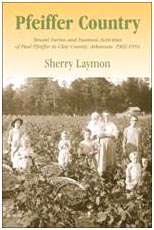As the title suggests, Sherry Laymon’s book focuses on the farm enterprises of Paul Pfeiffer, a wealthy midwesterner who began purchasing land primarily for cotton production in the swampy bottomlands of Arkansas’s northeastern Clay County in 1902. Pfeiffer ultimately amassed enormous wealth and acreage before selling off–under favorable terms–a majority of his landholdings to his tenant farmers in the early 1940s. This last act, combined with his benevolent management style, bolsters Laymon’s argument that Pfeiffer offered his farmers a kinder, gentler model for landlord-tenant relations, in contrast to the conditions experienced by sharecroppers and tenants in the Arkansas Delta specifically and the South generally. By extension, Laymon’s study challenges the conventional depiction of sharecroppers’ being subject to virtual bondage by ruthless landowners through crop liens and debt peonage.
In creating an agricultural utopia composed of “good farmers who seldom moved from their farms,” Paul Pfeiffer not only “avoided conflicts with tenants that other large planters encountered” but also managed to withstand the turbulent economic cycles of the early twentieth century (p. 13). Laymon provides ample evidence of Pfeiffer’s generous approach to farm management. For example, the landowner opted not to operate a commissary wherein his tenants would be forced to purchase staple items from him and be subject to exorbitant interest rates. He supplied a substantial two-story farmhouse to each of his tenants, supplemented by a series of outbuildings, including assorted barns and a chicken house. Pfeiffer provided general upkeep of his tenants’ properties, including drainage, an expensive but necessary task. Further, Pfeiffer allowed his tenants to allot a portion of their acreage to their own material needs, wooded areas for firewood, and an acre for home gardens.
All told, conditions in “Pfeiffer Country” seemed better than elsewhere for the average tenant farmer; still, there are some glaring issues that go largely unexplored in this analysis. The author posits Pfeiffer’s Clay County against the conditions of other sharecropping counties in the Arkansas Delta, mentioning only in brief that Clay was an all-white county and that the landowner advertised for “good white people … who believe in education, morality, and the better things of life” (p. 72). Pfeiffer preferred to recruit his tenants from the Midwest, after which these industrious folk needed to prove their mettle to him during their probationary first year. Obvious questions of class dynamics emerge between the ultra-rich Pfeiffers–who traveled in elite circles and whose eldest daughter married Ernest Hemingway–and their tenants (hinted at by Laymon’s assertion that the Pfeiffer women saw the local people as quite different from themselves).
The author does, however, provide a thorough examination of Pfeiffer’s business records and family correspondence. The firsthand accounts of Clay County tenants provide invaluable insights into early-twentieth-century rural life. While informative, the detailed descriptions of farm dwellings seem cumbersome and poorly integrated into the narrative. Paul Pfeiffer is a compelling figure who made a calculated business decision to not treat his tenants as serfs. However, to avoid hagiography, Laymon needs to rely less on her good-evil dichotomy and place Pfeiffer in the complicated, nuanced world in which he lived.
LINDA ENGLISH
University of Texas-Pan American

